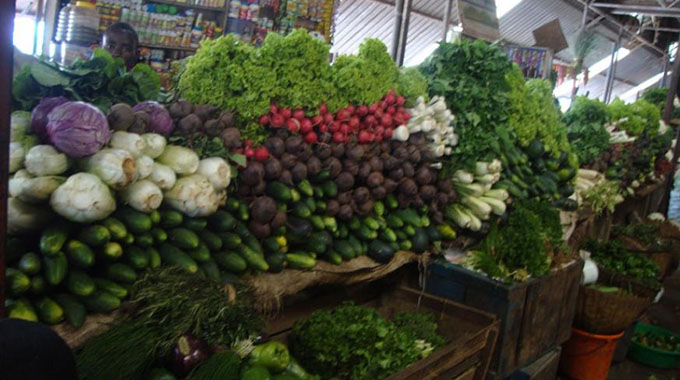Market hubs will make horticulture bloom
THE Agricultural Marketing Authority (AMA)’s recent decision to establish market hubs for fresh produce will essentially provide the panacea that the sector has been searching for over the years to take care of its seemingly unending marketing and viability challenges.
It is not a secret that farmers will emerge the biggest beneficiaries from this arrangement, with the economy also claiming its fair share of the cherry, especially if local produce can penetrate regional and international markets where by all standards, Zimbabwean horticultural produce has commanded a lot of respect.
Market hubs will no doubt boost sales and the horticultural sub-sector’s contribution to the national gross domestic product (GDP), which the present fragmented small-scale horticulture sector is failing to effectively do, especially as the country is targeting to boost its economic performance and achieve food self-sufficiency.
It is exciting to note that the project is expected to start in Harare where Mbare Musika forms the country’s biggest fresh produce market that on its own has created a multi-million-dollar economy in that part of town, creating thousands of jobs in the process. Millions of dollars exchange hands every day, but due to the fragmented nature of the system, farmers who produce the commodities have sadly been receiving the least revenue along the value chain.
Middlemen have taken advantage of the absence of clearly defined marketing structures to rip off farmers of their produce and ultimately revenue and have been the biggest winners in this little vignette of deceit.
Harare City Council has also not helped the situation much, with the local authority failing to devise ways of keeping the middlemen out of the matrix.
And now, a new dawn seems to be beckoning for the farmers, with AMA chief executive officer Mr Clever Isaya confirming that the programme would start in Harare where they would open a stand-alone mass market for potatoes to accommodate the recent increase in volumes.
Potatoes are regarded as a strategic national crop in Zimbabwe, while Mbare Musika is the country’s largest formal market for the crop and other horticulture products, accounting for the majority of volumes traded per week.
Amid the market’s lack of expansion to accommodate the growing number of farmers who want to sell their fresh produce, another challenge in the form of subdued trade volumes has also surfaced, forcing many farmers to turn to their local markets that are naturally not gone anywhere near being lucrative.
Market hubs are “businesses or organisations that are actively coordinating the aggregation, distribution, and marketing of source-identified locally or regionally grown food products from primarily small to mid-sized producers.”
They may provide the core services of a packing house and/or aggregate and distribute farm-packed products.
After fresh produce is harvested, it is either sold fresh or processed.
Fresh produce is cooled, packed, shipped, and sold to distributors, to wholesalers, or to end consumers through direct channels such as farmers’ markets.
If grown for processing, produce is delivered to a processing facility where it is either preserved or transformed to be used as an ingredient for a food product.
Currently, there are no or very few post-harvest aggregators and processing facilities in Zimbabwe whose size and location can successfully support small to medium-sized growers.
The vast majority, about 80 percent or more of wholesale distribution, is channelled through self-distributing retailers and sometimes through contract food service suppliers.
Due to consolidation in the grocery and food service industries, these are very large players with significant buying power.
The remaining 20 percent of wholesale distribution is run by food brokers, grower agents, and or other entities that facilitate sales and marketing without ever taking direct ownership of produce.
Direct-to-consumer channels, which include farm stands and farmers’ markets and community sale points are slowly taking the place of Mbare Musika as more growers realise that it is even becoming more economic to use other markets besides coming to Harare.
In this regard, market hubs can easily come in handy as critical players in establishing and building strong local and regional marketing systems.
Market hubs can provide efficient local and regional value chain linkages at a vastly reduced scale compared to leading industry players.
They also create opportunities for small to mid-sized producers to reach wholesale markets.
Market hubs can serve as aggregator, processor, and distributor, although not all market hubs play every role. Establishing the value chain through aggregation is often the first step in market hub development, and distribution and processing services may be added depending on local needs.
Market hubs will offer products and services to customers positioned both upstream and downstream in the value chain. Aggregators will sell services to growers and producers, as well as products to processors, buyers, and consumers.
Processors will sell services to growers, producers, aggregators, and small food businesses, who in turn will sell products to buyers and consumers.
The processor may also sell products directly to the customer.
Without access to appropriately-scaled post-harvest handling, processing, and distribution, growers have slowly moved away from diversified fresh market crops, resulting in a diminished supply of local and regional produce for large markets.
Studies indicate that money spent on locally-grown food creates a multiplier effect, internally circulating the same dollars within the local economy.
Market hubs create jobs from seasonal production to management.
Additionally, as food hubs encourage growers to convert acres from commodity to speciality crops, additional farm labour will be needed for manual harvesting.
A recent study in the United States showed that some jobs are created for every $100 000 in local food sales.
Growers on the other hand can also benefit from the significantly higher market value of fresh market crops by converting acreage from commodity crops.
And, by participating in value-added production, growers and producers can add a high-margin revenue stream to their farm businesses.-herald.cl.zw










